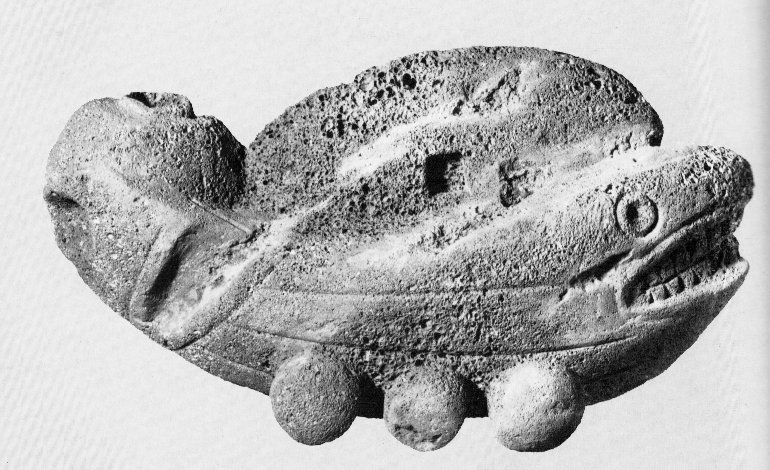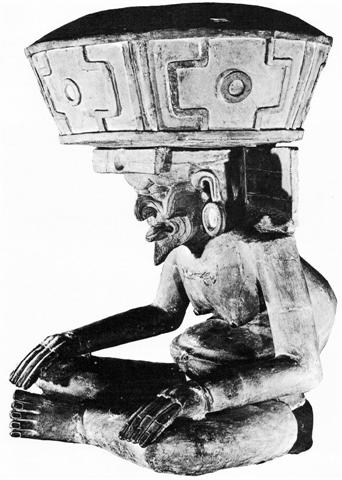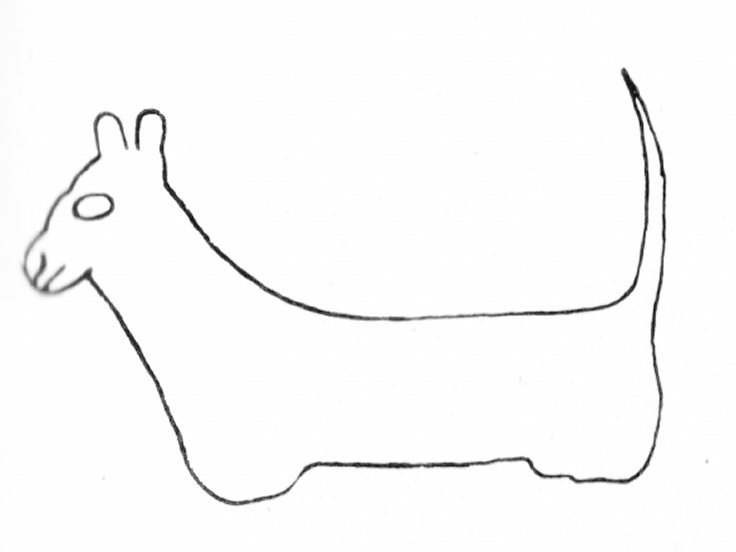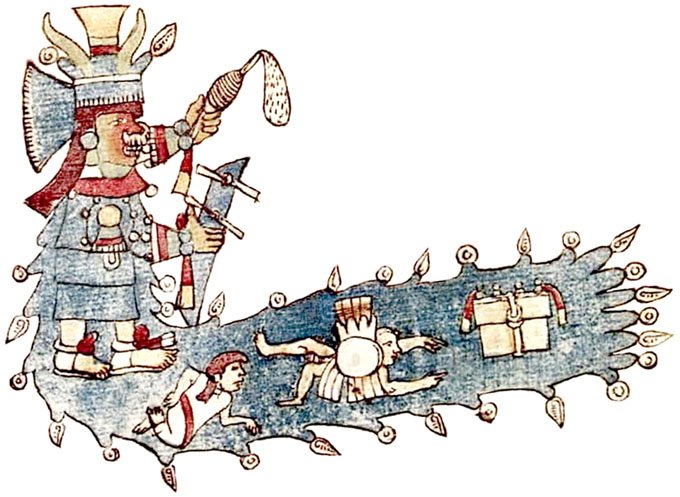The shape of moko makes me think about the 'sun-fish':

... The image is
that of a reed boat with a whale's or sea monster's head at the
bow, and a skull-like mask at the stern. At the top of the stern
is a five-sided umu, or Easter Island fireplace, and on
deck is a hare paenga, or lenticular reed house, with a
square doorway on the starboard side. On the same side, a wide
channel surrounded by a V-shaped groove leads down from the deck
aft ...
The skull-like mask at the
stern, together with a five-sided umu, clearly indicates
that at the 'tail' the light must be 'finished' and a new fire
alighted.
The gigantic head-piece of 'Xiuhtecuhtli,
the fire god, as Huehueteotl, the old god at the centre'
looks as if it has 5 sides too:

The severly bent back of the old god at the centre does not
resemble the smoother bending of the sun-fish. As I imagine it,
the smooth bending of the sun-fish represents the gradual change
over half a year.
The 6 balls under the fish may mean 6 solar
months (not as I thought earlier 6 solar double-months).
If the sun-fish means the light half-year, then the moko
probably means the dark half-year. That is what I suggest. The
sun-fish bends one way and the moko the complementary
way.
The moko means dark and underground, while a fish may
mean light and up above.
That moko (lizard) has to do with darkness is rather
obvious from what we have seen earlier:
…according to a legend told in
Hawaii, when a man named Ulu, dwelling near the present
city of Hilo, died of famine. He and his wife had a
sickly baby boy whose life was endangered by the general
scarcity of food, and the man, distracted, had gone in prayer to
the temple at Puueo, to learn from the god what should be
done. Now the god of that temple was of a type known in Hawaiian
as the mo'o: which is a word meaning 'lizard', or
'reptile'. But the only reptile in Hawaii is a harmless, even
affectionately regarded little lizard that scurries up and down
the walls of people's houses and clings like a fly to ceilings,
trapping insects with its quick tongue ...
... When Tuu Ko
Ihu came out and sat on the stone underneath which he had
buried the skull, Ure Honu shot into the house like a
lizard. He lifted up the one side of the house. Then Ure Honu
let it fall down again; he had found nothing. Ure Honu
called, 'Dig up the ground and continue to search!'
... Kena,
the name for the booby, is also an eastern Polynesian name. Line
18 of the creation chant lists as the mythical parents of
kena 'Vie Moko' and 'Vie Tea' (PH:520). The
'lizard woman' (vie moko) and her younger sister the
'booby woman' (vie kena) were considered the originators
of tattooing (ME: 367-368). The 'white booby woman' (vie kena
tea), together with other deities, protected the eggs of sea
birds (RM:260). She might even be considered to be the female
counterpart of the supreme god Makemake. In modern
Hangaroa, vie kena tea is a term of endearment for a
beloved wife whose well-rounded body and light skin is being
praised ...
Jaussen (according to Barthel):
... A une certaine saison, on
amassait des vivres, on faisait fête On emmaillotait un corail,
pierre de défunt lezard, on l'enterrait, tanu. Cette
cérémonie était un point de départ pour beacoup d'affaires,
notamment de vacances pour le chant des tablettes ou de la
priére, tanu i te tau moko o tana pure, enterrer la
pierre sépulcrale de lézard de sa prière ..
We have seen how for example the Aztecs
ordered the lizard close to the snake and death in their
20-day week:
|
1 |
Cipactli (alligator) |
11 |
Ozomatli (monkey) |
|
2 |
Ehecatl (wind) |
12 |
Malinalli (grass) |
|
3 |
Calli (house) |
13 |
Acatl (reed) |
|
4 |
Cuetzpallin (lizard) |
14 |
Ocelotl (jaguar) |
|
5 |
Coatl (serpent) |
15 |
Cuauhtli (eagle) |
|
6 |
Miquitztli (death) |
16 |
Cozcacuauhtli (buzzard) |
|
7 |
Mazatl (deer) |
17 |
Ollin (movement) |
|
8 |
Tochtli (rabbit) |
18 |
Tecpatl (flint knife) |
|
9 |
Atl (water) |
19 |
Quiahuitl (rain) |
|
10 |
Itzcuintli (dog) |
20 |
Xochitl (flower) |
In Heyerdahl 6 I found him comparing a strange unique statue
from Marquesas (Hivaoa Island), where the figure was not
standing up but lying down, with another strange figure
(similarly lying down) from Colombia (San Augustin):


(Hiavaoa statue above, San Augustin
below.)
The broad grin at the front is quite similar, not
only between these two lying down statues (if that word can be
used for non-standing figures), but also when
comparing with the sun-fish and the moko figures, I
think.
"... We find no analogy on any of the other
islands [this was presumably written before the 'sun-fish' of
stone was discovered on Easter Island], and we would have been
led to assume that this was an unorthodox and original creation
of the otherwise conservative Marquesan artist, had it not been
for the fact that a completely analogous monolith has been
discovered at San Augustin, the gateway to Andean cultures.
The close affinities between the general type of
monolithic statues left in these two areas have already been
mentioned. With the added convergence of the two exceptional
prone figures the likelihood of an underlying relationship seems
quite insistent; the similarity is too peculiar to be the work
of independent thought ...
... both are strangely stretched, horizontally on
their abdomens, in a strained pose. The very short, bulky arms
are bent forwards, one on each side of the face which is so
large that the hands do not project in front of it. In both
cases the body is extremely broad, stocky, and short, with very
stunted legs bent at the knees with the feet turned backwards.
The round head is huge, bent back without a neck and looking
forward and slightly upwards.
The eyes in both cases are large, the nose very
broad and very flat, and the mouth is simply enormous, carved on
both as a long and narrow oval spanning the entire lower portion
of the face from one side to the other, leaving space neither
for cheeks nor chin.
In the San Augustin mouth I can count to 20
teeth, two lines with 10 each. The Hivaoa mouth may also
have 20 teeth, but I cannot count these because of the poor
photograhps. Neither can I count the teeth of the 'sun-fish' from
Easter Island, but they seem to be plenty more, perhaps 32.
The figures have no dress or ornament other than
a strange object on top of the heads; it is carved as a flat,
wide crest, slightly raised, curving across the crown with
almost identical size on both figures. The only difference is
that in the Marquesas it is placed sideways over the crown
instead of lengthwise as on the San Augustine specimen ..."
(Heyerdahl 6)
I guess both these lying down 'statues' represent the sun and that
the idea is the same as that behind the Easter Island 'sun-fish'; Heyerdahl
6 (referring to the Hivaoa statue): '... it stretches its
five-feet length in a prone position, almost as if swimming ...'
"... On the dirt being removed from the base of
the pedestal [at Hivaoa] four figures carved
in relief round its base were exposed. The one at the front and
the one back were greatly stylized human figures each enclosing
a distinct cross.
The other two, sculptured one on each side, weree
animals with long body and raised neck, a stubby muzzle, rounded
ears, a raised tail and stunted, deformed legs ...

... My first impression was that these two animal
figures ... depicted some sort of dog, but a dog quite distinct
from what little is known about the extinct Polynesian kuri,
for it had a strangely erect and bare tail, rounded ears, and a
long even body.
Only when later confronted with illustrations of
the two four-legged, long-bodied, round-eared, and slim-tailed
animals carved in relief in a corresponding manner on the base
of the bearded Tiahuanaco monolith, did I begin to wonder
whether the two animals similarly reproduced on the Puamau
[Hivaoa] statue could have been based on a former
symbolism rather than on an unidentifiable type of dog used as
actual model.
The animals on the Tiahuanaco monolith represents
the locally important feline symbol, the puma ..." (Heyerdahl 6)
To try to find out whether the gigantic head-gear of the old
sun-god really had 5 crosses (with a ring in the middle) or not,
I tried Wikipedia:
"In
Aztec mythology, Xiuhtecuhtli ('Turquoise
Lord'), but also named Ixcozauhqui and
Huehueteotl ('old god') was the
personification of life after death, warmth in
cold (fire), light in darkness and food during
famine. He was usually depicted with a red or
yellow face and a censer on his head. His wife
was Chalchiuhtlicue.
"...
Censing is the
practice of swinging a censer suspended from
chains towards something or someone, typically
an icon or person, so that smoke from the
burning incense travels in that direction.
Burning incense generally represents the prayers
of the people rising towards Heaven. One
commonly sung psalm during the censing is 'Let
my prayer rise like incense before You, my hands
like the evening sacrifice' ..." (Wikipedia)
According to Codex Fejérváry-Mayer, a
prehispanic Mesoamerican manuscript,
Xiuhtecuhtli was considered, 'Mother and
Father of the Gods, who dwells in the center of
earth'.
At
the end of the Aztec century (52 years), the
gods were thought to be able to end their
covenant with humanity. Feasts were held in
honor of Xiuhtecuhtli to keep his favors,
and human sacrifices were burned after removing
their heart ...

There seems to be only 4 'sun-crosses' in the
'barbecue' head-gear of Huehueteotl. Though the
interpretation as crosses may be wrong: Between the upper and
lower rims there are 4 * 2 = 8 straight vertical 'staffs' and
between two such sets of vertical 'staffs' we have 'crooked'
staffs with a sun symbol in the middle.
The 'crooked' staffs are constructed from 5
segments each one of them, i.e. there are 4 * 10 = 40 such
segments in the censer. 40 + 8 = 48 segments (henua) in
all, 24 + 8 = 32 of which 'stand up', while 4 * 4 = 16 'lie
down'.
A mask of the 'turquoise lord' (Xiuhtecuhtli) according
to Wikipedia:

His wife (Chalchiuhtlicue) is described (in Wikipedia)
like this:
"... In
Aztec mythology, Chalchiuhtlicue (also Chalciuhtlicue,
or Chalcihuitlicue) ('She of the Jade Skirt') was the
goddess of lakes and streams. She is also a patroness of birth
and plays a part in Aztec baptisms. In the myth of the five
suns, she had dominion over the fourth world, which was
destroyed in a great flood. She also presides over the day 5
Serpent and the trecena [a 13-day period] of
1 Reed.
Her husband was
Tlaloc and with him, she was the mother of Tecciztecatl
and ruler over Tlalocan. In her aquatic aspect, she was
known as Acuecucyoticihuati, goddess of oceans, rivers
and any other running water, as well as the patron of women in
labor. She was also said to be the wife of Xiuhtecuhtli.
She is sometimes associated with a rain goddess, Matlalcueitl.
In art,
Chalciuhtlicue was illustrated wearing a green skirt and
with short black vertical lines on the lower part of her face.
In some scenes babies may be seen in a stream of water issuing
from her skirts. Sometimes she is symbolized by a river with a
heavily laden prickly pear tree growing on one bank ..."
We notice 'prickly',
reminiscent of the Bororo piqui fruits.

I count 13 'flames' issuing from her long flowing
'skirt', and 16 sun symbols. 13 + 16 = 29.
Moving from top left and counterclockwise sun
symbols and 'flames' (maybe droplets?) alternate in a regular
pattern (with sun symbol arriving before 'flame'). After the 7th
sun symbol, however, another sun symbol (the 8th) arrives.
Equally: after the 13th 'flame' the 15th sun
symbol is followed by another (the 16th) sun symbol.
Maybe this
structure depicts two half-years. Moving from top right (the
Aztec live north of the equator) we have two sun symbols
following each other, that could mean new year at winter
solstice. The 1st sun symbol will belong to the old year. The
1st half year may then contain 15 periods (8 sun symbols and 7
'flames'), and the 2nd half year 13 periods (7 sun symbols and 6
'flames').







